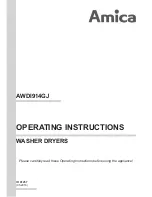
7
Inspect the unrolled power cord for damage or wear before
use. Have a damaged cable replaced at the manufacturer's service
center.
If the power cord becomes damaged during operation, disconnect
the power immediately. DO NOT TOUCH THE CABLE BEFORE
DISCONNECTING THE POWER SUPPLY.
ATTENTION: Despite the use of an inherently safe structure, the use of
safety measures and additional protective measures, there is always a
residual risk of injury during work.
Explanation of the pictograms used:
1 2 3
4
5
6 7 8
9
10
1. NOTE: Take special precautions to
2. Read the operating manual, observe the warnings and safety
conditions contained in it,
3. use personal protective equipment,
4. Disconnect the power cord before starting maintenance or repair
activities,
5. use protective clothing,
6. protect against rain,
7. Do not direct the stream at people, animals or live installations,
8. Second class of protection,
9. Risk of injury by high pressure,
10. Keep children away.
CONSTRUCTION AND APPLICATION
A pressure washer is a class II electrical protection device designed for
cleaning surfaces and objects under high water pressure. The pressure
washer is widely used in households, transport, construction, agriculture
and other areas of activity. It is especially suitable for washing cars, car
trailers, buildings, boats, ceramic tiles, etc. Appropriate accessories
enable mixing of cleaning agents. The device is placed on an ergonomic
trolley with handles for accessories and a drum for high pressure hose.
Do not use the device contrary to its intended use.
Graphic elements
1 Lance
2
High pressure hose drum
3
Touch control panel
4
High pressure hose outlet
5
Blockage / release of high pressure hose
6 Transport
wheels
7 Power
cord
8 Power
cord
holder
9 Crank
10 Transport
handle
11 Lance
holder
12 Accessory
holders
13 Main
switch
14 Detergent
container
15
Water inlet connection
16 Adjustable
nozzle
17
Quick coupler with filter
18
Water hose quick connector
Washer equipment
1 High
pressure
washer
2 Adjustable
nozzle
3 Lance
4 Detergent
container
5 User
documentation
6
Quick coupler with filter
7
Quick coupler for water supply hose
8 Lance
holder
9 Power
cord
holder
10 Accessory
holder
11 Drum
crank
PREPARING THE WASHER FOR WORK
Installation of the high pressure hose
Connect the high-pressure hose
(2)
integrated with the drum to the
washer outlet on the front of the washer
Fig. 1A
, make sure it is well
connected.
To disconnect the high pressure hose, push the button
(5)
to the right
Fig.
1B
and then remove the hose
Fig. 1
Lance connection
Connect the adjustable nozzle
(16)
to the lance
Fig. 2
. Turn gun lance
clockwise until it locks into place. Connect the high pressure hose to the
lance connector
Fig. 2A,
make sure it is connected securely.
Detergent container connection
Attach the detergent container
(14)
to the lance
Fig. 3A
. Turn the canister
counterclockwise until it locks into place. Make sure it is connected
securely.
Inlet hose connection
Screw the quick-release fitting with the filter to the water inlet Fig. 4A. Then
connect the water inlet hose
Fig. 4C
to the water inlet of the washer
through the quick coupler
Fig. 4B
.
The recommended minimum length of the water supply hose is 10 meters
(but not more than 25 meters) with a diameter of 12.5 mm to avoid back
pressure and possible damage to the unit. Make sure the hose can
withstand water up to a pressure of 10 bar (0.1 MPa). If you want to
connect the machine to other water sources, please make sure their
maximum water outlet pressure is 10bar (0.1Mpa).
Squeeze the lance trigger to make sure all air is pushed out of the machine
and water flows out of the gun. This means that the pump is now filled with
water.
WASHING WORK
Touch control panel
Make sure that the water supply hose to the washer is connected to the
inlet of the washer and then turn on the tap. Make sure that the washer's
hydraulic system is deaerated. Then turn on the main switch
(13)
on the
back of the washer
Fig. 5A
. The most important thing is not to forget to
press the button
Fig. 6A
on the touchscreen control panel to start the
device.
The control panel has a choice of three operating / water pressure
modes. There is a light mode in
Fig. 6B
, a medium mode in
Fig. 6C
and
a strong mode in
Fig. 6D
. When choosing the right pressure of water, you
should consider what the surface is being cleaned and the cap that best
suits the job.
If you want to increase the pressure level, press the button
+ Fig. 6F
on
the control panel. If you want to lower the pressure level, press the
button
- fig. 6E
on the control panel.
When you increase the pressure level so that the pressure indicator turns
red, the machine is operating at maximum pressure.
ATTENTION! Do not let the washer run continuously for more than
15 minutes at maximum pressure.
MAINTENANCE AND STORAGE
Before performing any maintenance or inspection, disconnect the
device from the power supply. Turn off the water supply and
squeeze the trigger to drain the water in the system.
Periodically lubricate the quick coupler fitting with the filter with
lubricating oil.
When the water pressure in the washer is not constant or too high,
the signal shows hose damage or calcium accumulation in the
nozzle. In this case, switch off the device immediately.
Regularly use nozzle cleaner to clean the hose and water inlet filter.
A worn or damaged filter should be inspected and replaced.
Make sure the machine is clean and clean the components if
necessary.
Follow the operating instructions for the various parts. Plug-in ring
nuts are used to connect the gun, hose and other parts. The seals
at the connections of the ring nut must not be damaged.
Turn the detergent tank over and attach it to the foam
nozzle. Connect the foam nozzle to the blast gun. Turn on the
machine. introduce cleaning agent in a proportion of 1%. Warning:
Use only dedicated cleaners.
Store the device in a safe and dry place. Always store the machine
out of the reach of children.
Avoid storing my us at temperatures below the freezing point of
water.
Cut off the power if the device malfunctions.








































